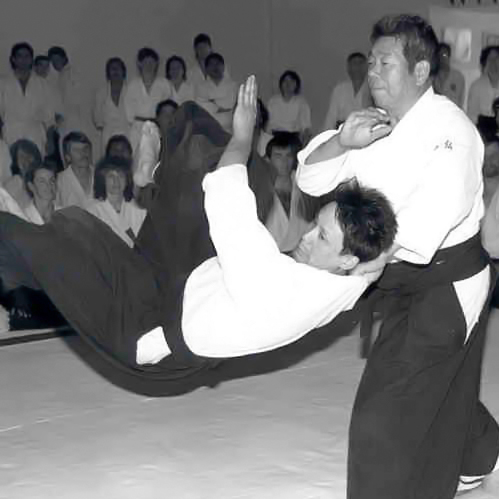
The Japanese text shown in this image is 頑張り合い稽古を禁止します (Gambariai keiko wo kinshishimasu) has a very interesting meaning. Which we should remember every time we are going to start our keiko on tatami. "Gambariai" can be translated as "fight against each other" but in the Japanese verb, there is a nuance that is lost in translation, namely what is forbidden is that two people fight against each other to try to see who is the strongest. It's not just Uke resisting Tori's technique, this sentence includes the responsibility of both partners to avoid this kind of unnecessarily competitive behaviour.
What makes this expression and the image that proposes it particularly interesting is the story it tells, well known to those who attended the Iwama Dojo when Saito Morihiro sensei was the custodian of Aiki Jinjia and directed the daily keiko. Saito Sensei often used the expression "Sunao no kimochi" with the meaning of having a sincere feeling during the keiko of Uke's role, so as to perform each technique as if it were the first time.
At that time a 外人 生徒 ,gaijin seito (foreign student ) had gone to the Ibaraki Dojo and blocked all his partners during keiko, and this annoyed Saito Sensei, also because others behaved in the same way, but this subject had become the proverbial straw that had overflowed the jar of Saito Sensei's patience because this practitioner – knowing in advance what technique he would have to undergo as Uke, in fact, he blocked every action of the Tori on duty and so in the end Saito Sensei excluded him from the tatami for a certain period of time until this subject understood the lesson and returned to practice in a more respectful way.

Despite the essentiality of the writing, this notice is important because it reminds us of one of the basic concepts of Iwama Aikido, or of the opportunity to perform our technique when our partner performs his, respecting the timing established by those who direct the practice. In doing so, the attacker will still be busy executing his attack and will not be able to oppose our action. In the event that Uke then resists, in general, we should use his strength to our advantage and not counter it.
Keiko with a Uke who resists can be an important and profitable part of our training. Still, it is appropriate that this happens between companions who know each other well, so that we can act with mutual benefit while remaining in a situation in which the safety of both is sufficiently guaranteed, without the confrontation degenerating into a violent brawl or a sort of tug-of-war in keikogi.

